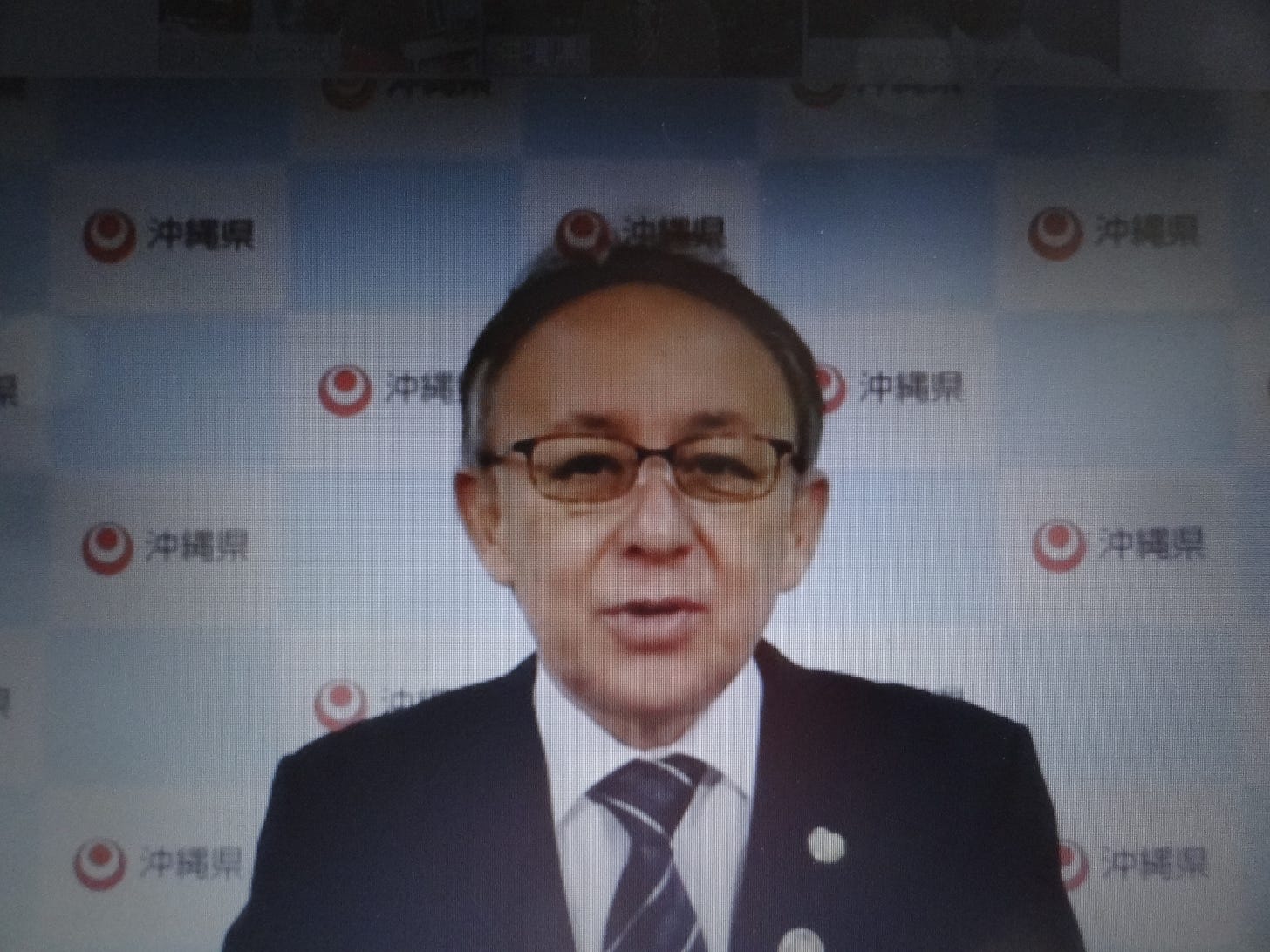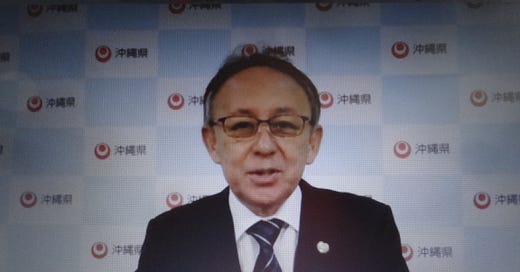Dear readers, 2022 has been an important year for Okinawa, Japan’s southernmost prefecture. First of all, it was the 50th anniversary of the Okinawa Reversion Agreement through which the United States returned the archipelago to Japan. The second important event was the gubernatorial election that took place on September 11.
The two things are closely related because though Okinawa has been officially returned to Japan in 1972, the US military presence is still strong and continue to cause problems to the local population.
That’s why I’m going to devote the next few posts to this subject, starting with my interview with the Governor of Okinawa, Tamaki Denny. I had a chance to talk to him in February on Zoom, a few months before he was re-elected. This is an abridged version of the interview which focuses on Okinawa’s relationship with the American presence in the islands.
Tamaki Denny likes to wear his bi-cultural heart on his sleeve. Born in 1959 from an American father and Japanese mother, Tamaki used his mixed heritage to win votes during the 2018 gubernatorial election campaign. Though his declaration that “the United States will listen to me because my father was American” was often taken as a joke, he won that election with 55% of the popular vote and this year he will try to keep his job as Governor of Okinawa Prefecture.
A music lover and former radio DJ, Tamaki avoids the strident anti-American propaganda of many Okinawan politicians and activists. But this does not mean he welcomes the U.S. bases in Okinawa. Indeed, he has long been an outspoken critic of the American military presence in the archipelago.
In fact, Tamaki was born close to one of those bases, on the tip of the Katsuren Peninsula, on Okinawa’s main island, and saw American soldiers almost every day.
“In the early ‘60s, when I was a small kid, the United States had been escalating their presence in Vietnam,” he says. “Even before that, there had been the War in Korea, civil unrest and the founding of the People's Republic of China, and the whole of South-East Asia was really unstable, so a lot of American soldiers were sent to Okinawa for a round of service.
In the area where I lived, there was a U.S. base and around the base, the locals had opened many shops catering to the soldiers. You had tailors, barbershops, etc. Even the Japanese could use those shops, of course, but the Americans were their main clients. And in the same districts there were many bars that were regularly frequented by the soldiers. Therefore, more than by my father, whom by that time I had almost forgotten, my immediate surroundings became my main link with American culture.”
Tamaki’s father was a marine who had fallen in love with a local girl. “My mother got pregnant with me,” Tamaki says, “but before I was born, my father was sent back to America. At first, my mother had planned to follow him, but then she started worrying about how hard it would be to adjust to a new life in the States. They kept in touch for some time, but when I was about one year old, she wrote a letter to my father, saying that she wanted to raise me in Okinawa. In the end they broke up. As a child, I was curious about the father I had never had, so eventually my mother burned all his photos and letters because she wanted me to forget about him.”
Tamaki traces his love of music back to those days. “From the open doors of the many bars in my area came the music they played on the jukebox. Even at that early age, I loved listening to music. I hid in the shadows close to the open door, so that I couldn’t be seen from the inside, and listened to all that wonderful Western pop music.”
While the anti-base movement was raging in other areas, the town where Tamaki lived was relatively quiet. “The teachers’ union and workers' unions were pretty active, but not so much against the Americans. One reason for that, besides the economic advantages I earlier mentioned, was that the base itself was located in an isolated spot of land on top of a high cliff while my town was at the bottom. Also, many of the soldiers belonged to the communications corps. There were no jet planes roaring over our heads or other activities that could disrupt our daily lives.
“When I was about four or five, I used to go up to the base to wait for the soldiers to come out. As soon as the gate opened and a car came out, we would shout “Chocolate! Chocolate!” or “Gum! Gum!” and they threw them to us. The best thing I remember is being given a whole apple. I was like, is it alright to eat it all by myself? Because you see, that was the first time I had the chance to bite into a whole apple. My mother used to give me just a slice because eating apples was a luxury.”
Tamaki’s childhood memories of the U.S. bases may be positive, but at the same time he was conscious that the American presence in Okinawa could also be a source of troubles. “I was born in October 1959. In June that same year, a jet plane that had taken off from Kadena Air Base crashed into an elementary school in Ishikawa City, and many students and staff either died or were injured. Other accidents occurred after I was born, but the worst thing was that no matter what happened, the Okinawa citizens or even the Ryukyu police were totally powerless. The U.S. military was a self-contained community and if a member of the armed forces caused an accident or committed a crime, he was court-martialed but wasn’t handed over to the Japanese. Since a young age, I got used to listening to similar news and knew that what was happening was wrong and unfair.”
Tamaki had just started junior high school when Okinawa formally reverted to Japanese authority in 1972 after 27 of U.S. military rule. “Since then, Okinawa Prefecture has benefited from several projects undertaken under the Okinawa Promotion and Development Special Measures Law,” he says. “Thanks to the financial aid from Tokyo, we were able to improve the archipelago’s infrastructures, making new roads, and building dams, ports and airports. We have achieved a substantial growth whose results can be seen today, and we were able to develop important tourism and telecommunications-related industries. However, many problems dating back to the military rule were left unsolved.”
Okinawa Prefecture was created 50 years ago, upon the islands’ return to Japan. At that time, the general mood was that the Japanese government had managed the whole process without taking into consideration the interests of the people of Okinawa. Therefore, the new prefecture presented a Proposal for Reinstatement Measures, also known as the Yara Proposal (Yara Chobyo was the first governor of Okinawa, from 1972 to 1976), a 132-page document that expressed the Okinawans’ desire to see their basic human rights guaranteed under the national Constitution.
“This proposal,” Tamaki says, “urged the government to give top priority to the welfare of the citizens of the prefecture within the framework of local autonomy and economic development. Another important point was that Okinawa should become an “island of peace” without U.S. bases. But in the end, things went quite differently.
Even now, as we celebrate this 50th anniversary, while the areas occupied by the U.S. military bases have decreased in Japan as a whole, Okinawa continues to carry most of the weight: in fact, 70.3% of those bases are concentrated in our prefecture. Sadly, the kind of redistribution throughout Japan that the people of Okinawa wished for never happened.
When asked about the future of the U.S. bases, Tamaki points out the delays and broken promises on the part of the central government. “In the 1950s, the U.S. military presence in Okinawa was justified first with the need to support the American armed forces fighting in the Korean Peninsula then with the dangerous influence that other conflicts and social uprisings in Asia may have on our country. However, this did not stop the creation of a fierce opposition movement, not only to the continued presence in Japan of the soldiers who had defeated us in the war, but also to the bases’ negative influence on our postwar society.
“In 1996, while discussing the renewal of the lease on land used by the bases that was due to expire, the U.S. government agreed to return all or part of 11 military bases on Okinawa in five to seven years, or about 20% of the land currently occupied by American troops in Okinawa. This plan was confirmed in 2006. However, to this day, little has been accomplished. Moreover, even if this plan is actually put into practice, the percentage of U.S. bases in Okinawa will only go down from 70.3% to 69%.
“Considering all the things that have happened since that first agreement of 25 years ago, I think that the time has come to reduce the number of U.S. military bases in Okinawa and distribute them instead throughout the country. As things stand now, Okinawa cannot go on shouldering the social and economic costs of the American presence.”
One of the recent foreign politics developments that worry Tamaki is the rising confrontation between the United States and China. “We will never allow Okinawa to be the target of another military conflict like World War II,” he says. “Our request is that the Japanese and U.S. governments concretely proceed with the land return plan by decreasing the U.S. bases to no more than 50% of the American facilities in Japan. To do this, we are requesting that they set concrete numerical targets and stick to the plan. Ultimately, our vision for the 21st century is that Okinawa becomes a peaceful and prosperous island without military bases.”

There’s more to come about Okinawa, its history, culture and natural beauty. Stay tuned!






This is so very insightful, and I'm looking forward to more :)